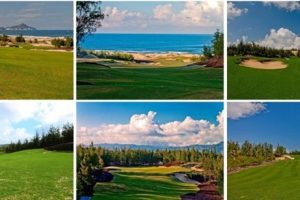Greg Norman has made his mark on golf as a player, businessman and course architect. To help celebrate the release of our Top 100 Courses for 2016, the World Golf Hall of Fame member sat down with Australian Golf Digest to reflect on reaching his 100th course design project, what makes a golf course timeless and which world-famous layout fails to live up to its hype.
Greg Norman, the architect, has designed and built more than 100 golf courses in 34 countries. Greg Norman, the golfer, won 90 tournaments around the world and triumphed in two Major championships.
Naturally, one would assume he has heard it all. Except for one question: What is the most overrated golf course in the world?
“Oh, wow… Geez… No one has ever really asked me that,” laughs the Great White Shark. Norman, 61, doesn’t assume he has a God-given right to criticise – though he has certainly earned it after four decades in this game.
So, he obliges.
“I’m going to get lambasted for this,” Norman tells Australian Golf Digest from his Florida home.
Possibly. But who could win an argument with a golfer who held the world No.1 ranking for 331 weeks? Besides, surely someone who has taken golf to the far reaches of the globe with a mammoth design portfolio has the authority to name a world-renowned course that falls a club short of its hype.
“I think Pebble Beach is a little overrated,” says Norman. “I think Pebble Beach has 13 magnificent holes – and five very average holes.”
The assertion may come as a shock to those with a soft spot for the iconic layout that sits atop an inspiring stretch of Californian coastline – recognisable even to non-golfers. After all, the 97-year-old layout has hosted the US Open five times.
“When you look at comparisons of Pebble Beach to, say, New South Wales Golf Club, I think you have to take away the scenic beauty (from each) and focus on playability; how the golf course flows,” says the long-time Florida resident.
“NSW has no houses on it, Pebble beach is surrounded by houses. But I think one of the most underrated courses out on the Monterey Peninsula (site of Pebble Beach) is Spyglass Hill. It’s a better golf course than Cypress Point – at least from a player’s perspective.”
If the 20-time US PGA Tour winner was to be ‘lambasted’ for his Pebble Beach review, his Cypress Point assertion may draw even more criticism.
Some critics will argue Cypress Point is the world’s best golf offering; continually ranked in the top-five on the World’s Greatest 100 Golf Courses list. Recently, it came it at No.4 behind Royal County Down, Augusta National and Pine Valley. Yet Norman’s job – in this chapter of his life – is to understand what separates a great course from an average one.
A Juggling Act
Norman’s architectural style is befitting of a two-time British Open champion and 14-time European Tour winner – one encouraging a ground-based game, while encompassing spin and bounce as hazards.
“I hated one-dimensional golf courses – where you can only play the game one way (with) no thought process to challenge the player, especially ‘target golf’ courses built in the ‘80s and ‘90s that were (only) played through the air,” says Norman.
“I love to see the ball roll and bounce and how much spin you can put on it.”
Yet the Shark’s style is still at the mercy of a developer’s piece of real estate – and budget. But the way Greg Norman Golf Course Design (GNGCD) attempts to bridge this gap is balance. “The easiest thing in the world is to build the most difficult golf course in the world. The hardest thing in the world is to build the most balanced golf course,” he says.
“(As an architect) you should be able to make golf courses very accessible, very playable, environmentally friendly and user friendly.”
According to Norman, balance is essential if the Australian golf course industry is to rebuild itself in the aftermath of the ‘championship boom’ of the 1990s, when golfers were desperate to play the same brutal layouts as their idols on the US PGA Tour.
This championship fad – and the ‘endless’ budgets required to fund it – are to blame for a current golf economy where one course closes every 48 hours in the US, while clubs in Australia merge to survive, says the Shark. “Our responsibility as designers is to get away from the ‘80s and ‘90s and thinking that we can build golf courses with an unlimited budget,” he says.
“I truly believe the demise of golf, especially in (the US), was because of the cost of building these golf courses with designers going off with unlimited budgets and designing golf courses that cost $2.5 million per year to maintain.
“That cost was handed down to memberships, and that was the chokehold – disposable income is the first thing that gets cramped down on during a recession.”
But how does an architect achieve this balance? What is the right mix of long and short, brutal and opportunistic, beautiful and rugged, or natural and artificial?
The answer, Norman asserts, can be found on some of Australia’s most timeless courses – Royal Melbourne, Kingston Heath and Ellerston. “It’s the ‘least disturbance approach’,” says Norman. “You look what (legendary architects) Alister MacKenzie and A.W. Tillinghast created – that’s where I took my inspiration.
“At Royal Melbourne, every green complex sits there naturally; beautifully. It wasn’t forced in there. Ellerston is the same; every green sits there magnificently.”
Changing Of The Guard
While the Sandbelt has long enjoyed a monopoly as Australia’s most prolific golfing region, the Shark believes more destinations are going to rival Melbourne’s revered southeastern suburbs – starting with Tasmania’s spectacular King Island.
Once famous only for King Island Dairy, the Bass Strait island now boasts Australia’s thirdbest golf course at Cape Wickham, which also made its debut at No.24 on the World’s Greatest 100 Golf Courses.
In addition, a highly anticipated layout is nearing completion at neighbouring Ocean Dunes, while Norman himself has submitted an initial routing for a GNGCD course proposed at the southern end of King Island.
“I think it’s a great thing; we need to have golfing destinations that entice golfers to travel in groups,” says Norman. “You see it in Ireland, Scotland and the US.
“I enjoyed the (GNGCD) site at King Island; it’s a magnificent piece of property and when you’re lucky enough to be on a piece of property like that it’s a pleasure.
“I’ve walked the property and completed my initial routing. It will be very natural if we do get to build a golf course there; very blended in that least disturbance approach.
“I’ve paid really close attention to the most natural green settings we can possibly have and I’ve played a lot of golf down there. I know the wind and I always ask myself, Can you play this hole in a 30-mile (per hour) downwind and a 30-mile headwind?”
Norman also suggested South Australia’s Kangaroo Island could emerge as a domestic golf tourism hotspot in the future.
“Kangaroo Island is a sleeper; it’s really undiscovered (for golf) and a lot more people visit Kangaroo than King Island.”
Norman The Centurion
Like his playing career, Norman’s design portfolio is full of accolades: architect of the first grass golf course in Jordan, and winner of the 2015 World’s Best New Course (for The Bluffs Ho Tram, Vietnam) are recent highlights.
But the Shark reached a more sentimental achievement last year when he notched up his 100th design with the Eastern Golf Club in Yering, Victoria. Norman’s conquest of his homeland has yielded 17 courses.
“Australia has been a really good hotbed for us and I appreciate all the support we’ve had back home,” he says.
“When I started the golf course design work, I never thought I would open 100 golf courses and it was a great experience to reach that milestone in Australia.”
But what is his favourite Australian course?
“Oh boy, you’re going to get me into trouble on this one,” laughs Norman.
“I really enjoy Brookwater (Queensland); it’s a great golf course, but I have to say Ellerston (in the NSW Upper Hunter region).
“I think it is a gem. I built it on behalf of the late Kerry Packer, God rest his soul, and he wanted a one or two-tee golf course where you have to play exceptionally well just to score. You don’t get an opportunity to do that very often.”
But Cathedral Lodge – a layout GNGCD is constructing on Victoria’s picturesque Goulburn River – is set to give Norman’s personal ranking a shake up when it opens, possibly in 2017.
“I think Cathedral Lodge just may tip the scales and take No. 1 spot away from Ellerston.”
The article "Norman The Conqueror" was originally published on http://www.shark.com/sharkwatch/news/australian-golf-digest-march-2016/





